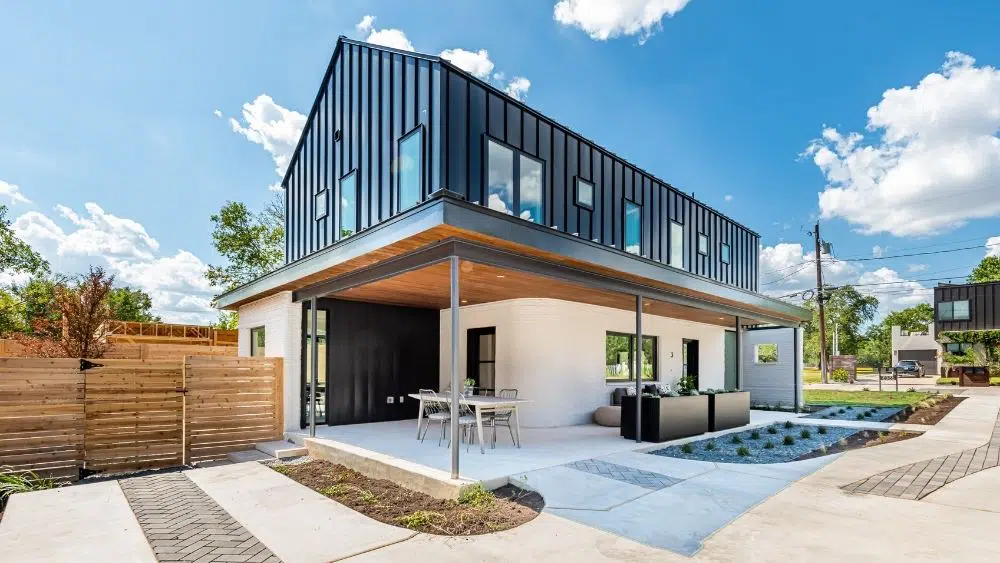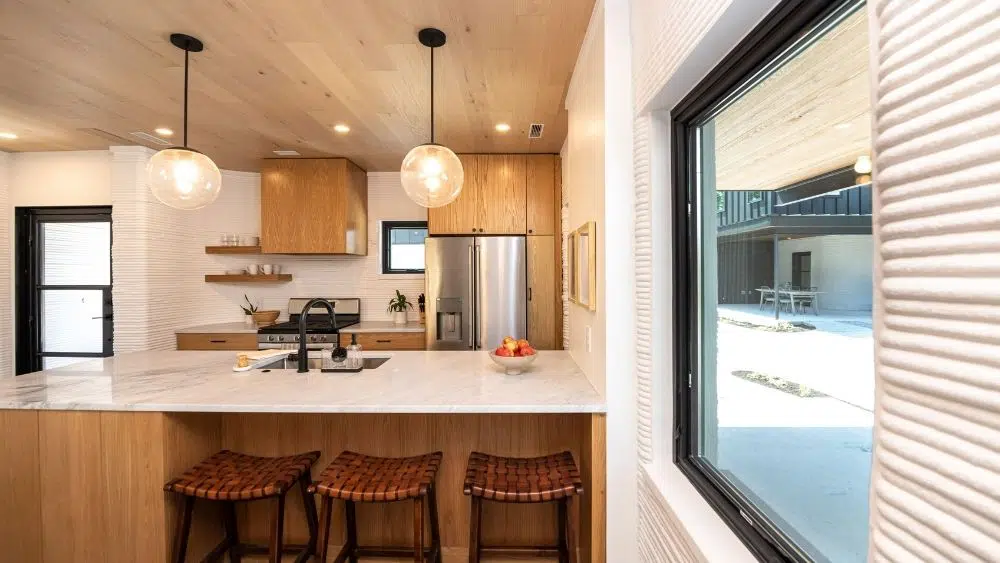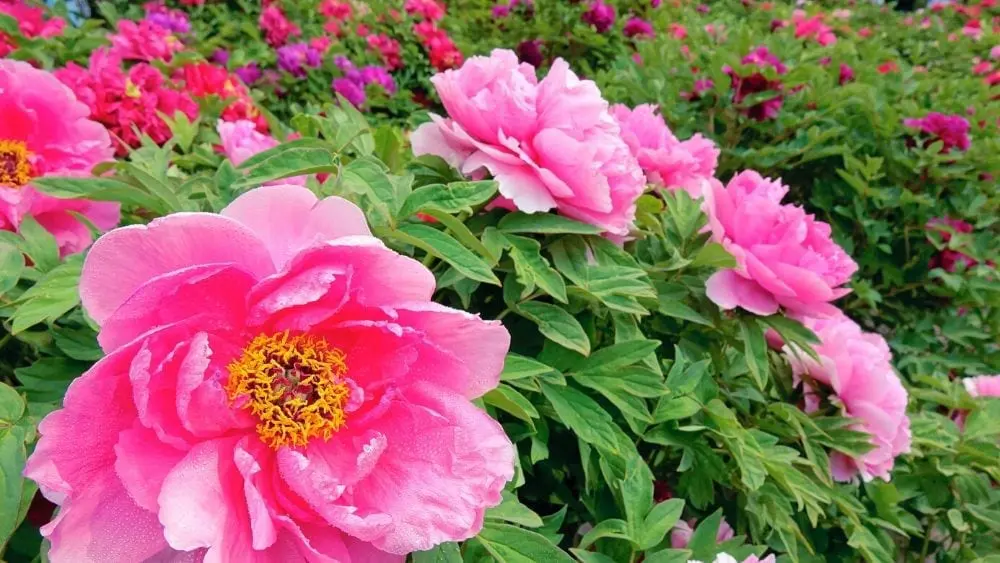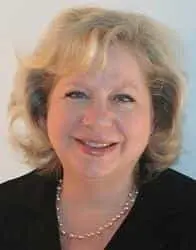
As the cost to build new housing soars, and home shoppers increasingly care about the environmental impact of their living spaces, 3D printed houses may provide a way to increase housing inventory in an affordable and responsible manner.
Developer 3Strands partnered with ICON, a high-tech Austin-based construction company, to build four single-family homes known as the East 17th Street Residences in Austin. Buyers quickly snapped up three of the homes, with the fourth home reserved for short-term rentals for people who want to experience living in a 3D printed property, says Gary O’Dell, CEO of Kansas City-based 3Strands.
“3D printing feels like science fiction, but we wanted to be the catalyst to get the technique out of the lab and into the field,” says O’Dell. “We’re real estate nerds and entrepreneurs with backgrounds in workforce housing and affordability issues. We see 3D printing as a solution to the fundamental issue that we’re not building enough houses where people want to live.”
3Strands and ICON partnered with Andrew Logan of Logan Architecture in Austin to design the four residences along with Austin-based designer Claire Zinnecker, who designed the interior finishes and fixture selections.
“We initially planned to build traditionally on the site but we know there’s a housing crisis in Austin and we wanted to maximize the site with as many homes as possible,” says O’Dell. “We chose to build two two-bedroom homes and two four-bedroom homes to show the options for this type of development.”
The first level of each home was 3D printed using ICON’s Vulcan construction system with “Lavacrete,” a mixture engineered to allow ICON to print under different environmental conditions.
“Lavacrete is a proprietary mortar formula that is unique for our current and future printing projects,” says Bungane Mehlomakulu, head of building science and building performance at ICON. “Lavacrete helps us to deliver durable, energy-efficient homes at speed and at scale.”
While O’Dell says the walls feel different than traditional buildings, they’re highly energy-efficient and resilient.
“The 3D printed walls aren’t paper, they’re concrete and feel extremely sturdy and substantial,” he says.
Modern architecture meets high-tech construction

The four homes in East Austin feature minimalist architecture with high ceilings, large windows, deep covered front porches, and covered parking. The two-story homes have open floor plans and vaulted ceilings in the master bedrooms. The two larger homes each have a secluded first-floor bedroom that can function as a home office. The homes, which were listed for sale for $450,000 to $795,000, range in size from 952 to 1,928 square feet.
“The median sales price in Austin is $565,000, and in that neighborhood, there’s not another 2,000-square-foot home priced under $1 million,” says O’Dell.
Because these homes are meant to showcase their unusual 3D printed construction, the developers chose to leave the concrete interior walls exposed. The ceilings look like wood to contrast with the concrete walls and floor.
“We think it looks cool, but you can also cover the concrete with drywall if you want,” says O’Dell. “The outside can be stucco if you prefer a more traditional look.”
Environmental benefits before and after construction

The 3D printing technique provides a quicker automated construction process that reduces waste compared to traditional construction, says Mehlomakulu. Building the average American home generates approximately four tons of construction waste, he says.
Waste reduction is not the only environmental advantage of this technique. The concrete in 3D printed homes provides thermal mass that slows heat transfer into and out of the home.
“This means homes are better able to withstand temperature swings, like a cold snap or heatwave, without increasing air conditioning or heating costs,” says Mehlomakulu. “The combination of thermal mass, increased insulation and an airtight wall increases energy efficiency for 3D printed homes and reduces utility bills.”
While newly built homes provide greater energy efficiency than older homes, 3D printed homes don’t require taping and sealing to achieve a higher level of efficiency.
“An airtight envelope enclosure is already built-in with our printed wall system so it doesn’t require additional steps to achieve this performance,” says Mehlomakulu. “A tighter envelope enclosure helps to make sure there is no infiltration of moisture and air that can have an impact on air conditioning and homeowner comfort and make a home less energy efficient.”
Resilient and more affordable homes

Homes built with 3D printing can help solve the challenge of designing a building to withstand fire, flood, wind, and other natural disasters at an attainable price. Lavacrete has passed numerous structural and materials tests to prove its resiliency.
“ICON’s proprietary wall system and advanced materials are stronger and longer-lasting than traditional building materials and provide safer, more resilient homes that are designed to withstand extreme weather and greatly reduce the impact of natural disasters,” says Mehlomakulu.
The ability to print the walls significantly reduces construction time, which in turn lowers costs. It also eliminates human error that can lower the quality of a stick built house.
“The fun part of the Austin project is that the 3D printed component of each house took about a week to complete, which saved tons of time,” says O’Dell. “And the printer never gets tired. We expect to roll out bigger scale projects in the future because the more you do at one time, the bigger the savings.”
Future of 3D printing

The housing shortage in the U.S. is huge because of both supply and labor shortages, and multiple solutions are needed, says O’Dell. He believes 3D printing could offer an answer, especially as technology matures.
“Existing materials have failed to meet the demands and challenges of the housing crisis,” says Mehlomakulu. “Current homebuilding methods are labor-intensive to construct and time-consuming to complete. Home enclosures involve multiple trades resulting in delays and increased costs. Prefabrication approaches have been around for decades without creating real change in the industry. The industry is in need of a shift.”
The durability and resilience of 3D printed homes can be achieved with fewer materials without costly construction and while reducing landfill waste, he says. In addition, the streamlined construction process can overcome the shortage of construction labor.
ICON has multiple projects underway including disaster relief housing, market-rate housing, and affordable housing, and is working with NASA to develop construction systems to create infrastructure and habitats on the Moon and Mars.
“The East 17th St Residences are a profound step for ICON, in partnership with 3Strands, to build beautiful, well-designed 3D homes that are a better value than conventional construction,” says Mehlomakulu. “It’s even more exciting to think this is just another step in discovering what is possible with this technology.”

Michele Lerner is an award-winning freelance writer, editor and author who has been writing about real estate, personal finance and business topics for more than two decades.
 8 Best Types of Hot Tubs for Your Home
8 Best Types of Hot Tubs for Your Home